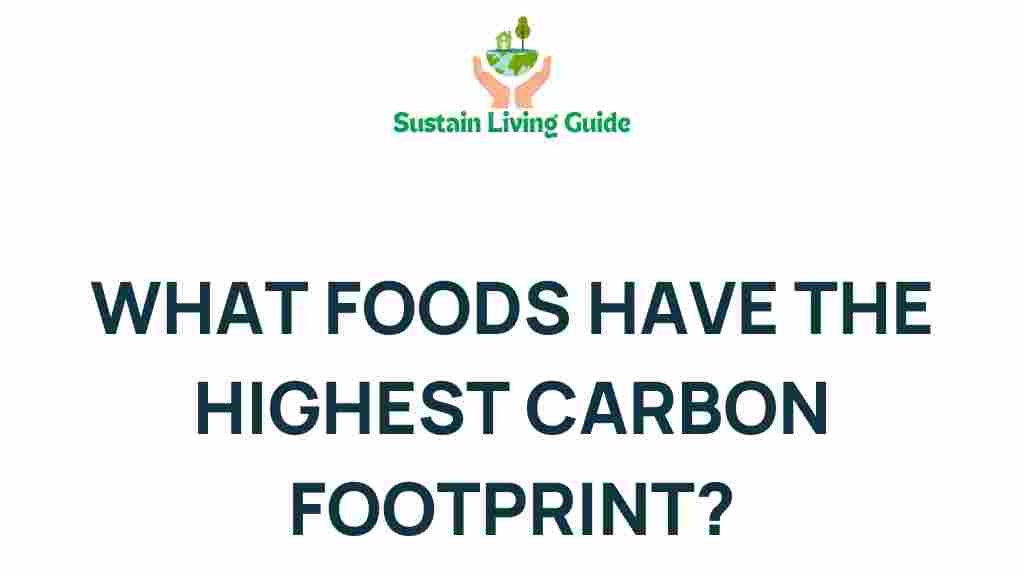Uncovering the Foods with the Highest Carbon Footprint
In today’s world, where environmental concerns are at the forefront of discussions, understanding the carbon footprint of the foods we consume is essential. The term carbon footprint refers to the total greenhouse gas emissions caused directly and indirectly by an individual, organization, event, or product, measured in units of carbon dioxide equivalents (CO2e). This article will delve deep into the foods that contribute significantly to our carbon footprint, helping consumers make informed choices that can lead to a more sustainable future.
Why Does Carbon Footprint Matter?
The carbon footprint matters because it reflects the environmental impact of our daily choices, especially in our diets. Agriculture, food production, and transportation are significant contributors to greenhouse gas emissions. By understanding which foods have a higher carbon footprint, we can take steps to reduce our overall environmental impact.
Foods with the Highest Carbon Footprint
Now, let’s explore some of the foods that rank high on the carbon footprint scale:
- Beef: Beef production is one of the leading contributors to greenhouse gas emissions. The methane produced by cattle, along with the land and water required for raising them, leads to an enormous carbon footprint.
- Lamb: Similar to beef, lamb production is also associated with high methane emissions. The carbon footprint of lamb is significantly higher than that of many other meats.
- Dairy Products: Milk, cheese, and butter have a considerable carbon footprint, primarily due to the methane emissions from dairy cows and the resources needed for their care.
- Pork: While pork has a lower carbon footprint compared to beef and lamb, it still contributes significantly to greenhouse gas emissions, particularly in large-scale farming operations.
- Processed Foods: Many processed foods require extensive energy and resources for production and packaging, leading to a higher carbon footprint compared to whole foods.
- Rice: The cultivation of rice emits methane, especially in flooded fields, making it a notable contributor to global greenhouse gas emissions.
- Avocado: While considered a health food, the intensive farming practices and transportation of avocados contribute to a surprisingly high carbon footprint.
- Chocolate: The production of chocolate involves deforestation and extensive water usage, resulting in a substantial carbon footprint.
How to Calculate the Carbon Footprint of Foods
Understanding the carbon footprint of foods can be complex, but here’s a simplified step-by-step process to help you gauge it:
- Research Sources: Start by looking for reliable data from environmental organizations or scientific studies that assess the carbon footprint of various foods.
- Consider Production Methods: Different farming practices can lead to variations in carbon emissions. For instance, grass-fed beef has a different footprint compared to grain-fed beef.
- Evaluate Transportation: The distance food travels from farm to table significantly impacts its carbon footprint. Locally sourced foods typically have a lower carbon footprint.
- Account for Processing: Foods that undergo extensive processing and packaging will have a higher carbon footprint compared to fresh, whole foods.
- Use Carbon Footprint Calculators: Several online tools allow you to input food types and serving sizes to estimate their carbon footprint.
Tips for Reducing Your Carbon Footprint with Food Choices
Reducing your carbon footprint doesn’t mean you have to give up delicious foods. Here are some actionable tips:
- Opt for Plant-Based Foods: Incorporating more fruits, vegetables, grains, and legumes into your diet can significantly lower your carbon footprint.
- Choose Local and Seasonal Produce: Foods grown locally and in season require less transportation and storage, reducing their carbon footprint.
- Limit Red Meat Consumption: Try to reduce the amount of beef and lamb you consume, opting for chicken or plant-based proteins instead.
- Reduce Food Waste: Plan meals carefully and use leftovers creatively to minimize food waste, which is a major contributor to greenhouse gas emissions.
- Support Sustainable Farming: Look for products from farms that practice sustainable agriculture. These methods often result in lower carbon footprints.
- Educate Yourself: Stay informed about the environmental impacts of food choices. Knowledge is power when it comes to making sustainable decisions.
Troubleshooting Common Misconceptions
As consumers become more aware of their carbon footprints, several misconceptions can arise. Here are a few common ones, along with clarifications:
- Myth: All plant-based foods have a low carbon footprint.
- Fact: Some plant-based foods, like avocados and almonds, have a higher carbon footprint due to intensive farming practices and water usage.
- Myth: Frozen foods are worse for the environment than fresh foods.
- Fact: Frozen foods can retain their nutrients longer and reduce waste, making them a more sustainable option in many cases.
- Myth: Organic foods always have a lower carbon footprint.
- Fact: While organic farming practices can be more sustainable, factors like transportation and production methods can still affect their overall carbon footprint.
Conclusion: Making Informed Choices
Understanding the carbon footprint of the foods we consume is crucial for making informed dietary choices that align with our values of sustainability and environmental responsibility. By focusing on foods with a lower carbon footprint and being mindful of our consumption patterns, we can collectively reduce our impact on the planet.
Start by implementing small changes in your diet, such as increasing plant-based meals and supporting local farmers. Remember, every little bit helps in the battle against climate change. For more information on sustainable eating practices, check out this resource.
By uncovering the foods with the highest carbon footprint, we empower ourselves to make choices that not only benefit our health but also the health of our planet. Let’s strive for a sustainable future, one meal at a time.
This article is in the category Food and created by SustainLivingGuide Team
